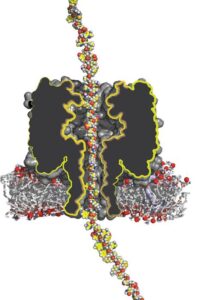Single-molecule protein sequencing may unlock new areas of the proteome. Multiple different technologies are emerging, and being commercialized by companies. One method is based on nanopore technology—a well-established method for sequencing DNA where the DNA is read as a single strand when it is pulled through a nanopore in a membrane.
However, moving a protein through a nanopore is far more challenging than DNA. “It’s like cooked spaghetti,” explained Giovanni Maglia, PhD, professor of chemical biology at the University of Groningen. “These long strands want to be disorganized, they do not want to be pushed through this tiny hole.”
Now, Maglia and his team have developed a way to overcome some of those challenges. Maglia tweeted that they “could successfully engineer a force capable of transporting polymers across nanopores, even against their charge.”
This work was published in Nature Biotechnology in the paper, “Translocation of linearized full-length proteins through an engineered nanopore under opposing electrophoretic force.”
Single-stranded DNA can be pulled through a nanopore with an electric field because of its electric charge. But proteins can be either positively or negatively charged. “Proteins and DNA are different,” Maglia explained, “so the technology needs to be adapted.”

To transport a protein through a nanopore, Maglia’s team used a solution of ions, which can be pulled through the nanopore with an electric field. When this happens, they drag along the protein. “We didn’t know whether the flow would be strong enough. Furthermore, these ions want to move both ways, but by attaching a lot of charge on the nanopore itself, we were able to make it directional,” noted Maglia.
The researchers engineered a system with the strongest possible flow without proteins. Computer simulations revealed that the force of this flow on a protein was comparable to the force of the electric field on DNA. They then tried it on a difficult protein: one with many negative charges, that would act to move it in the opposite direction of the flow. But even then, the flow was strong enough to pull the protein through the nanopore.
More specifically, they wrote that “the introduction of sets of charges in the lumen of the CytK nanopore spaced by ~1 nm creates an electroosmotic flow that induces the unidirectional transport of unstructured natural polypeptides against a strong electrophoretic force.”
“This proves that there is no fundamental limitation to sequencing proteins anymore,” noted Maglia. His startup company, Portal Biotech, intends to commercialize the nanopore technology. “With this latest research result, we have the missing piece that we needed to make protein sequencing happen.”


